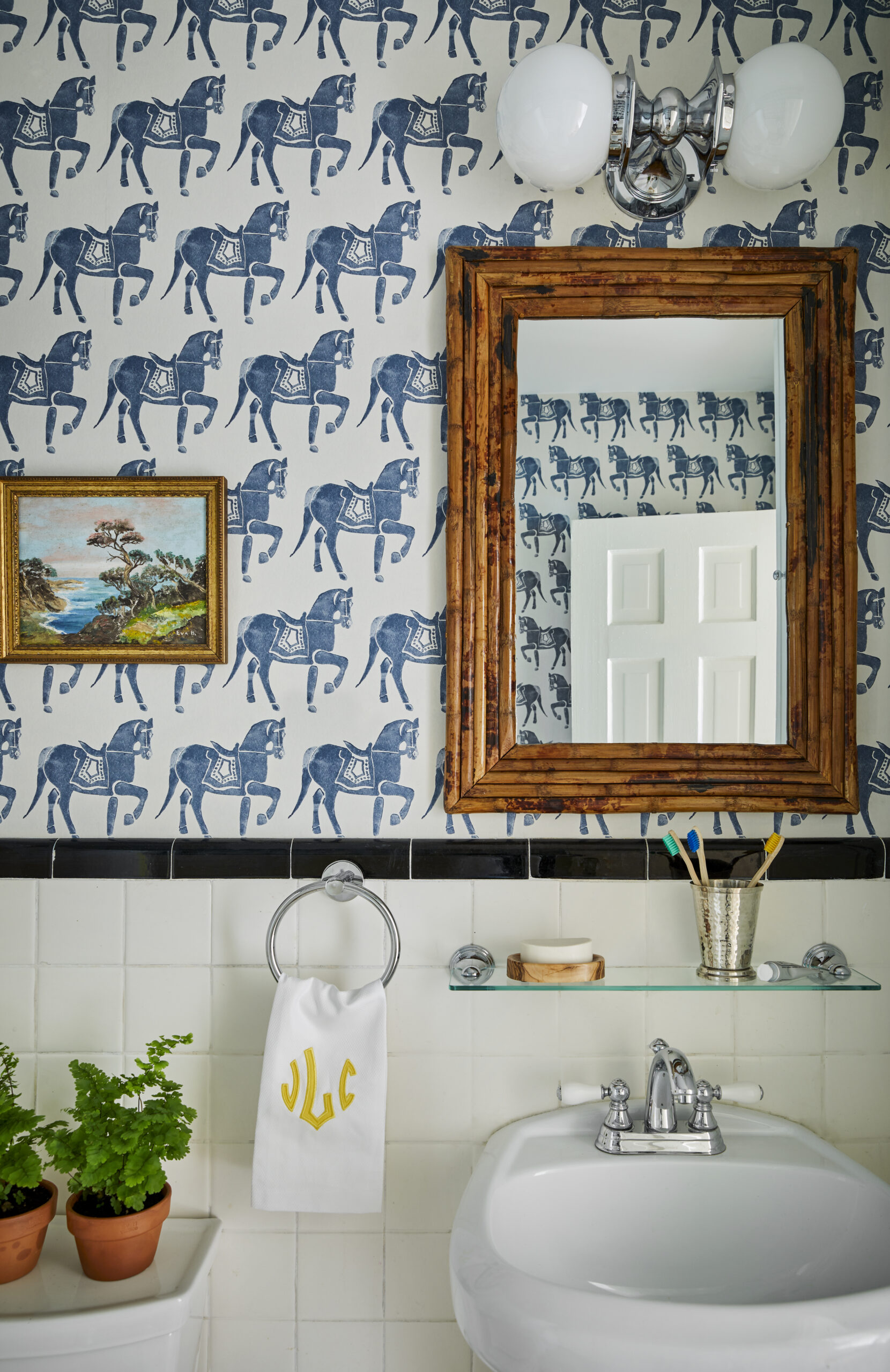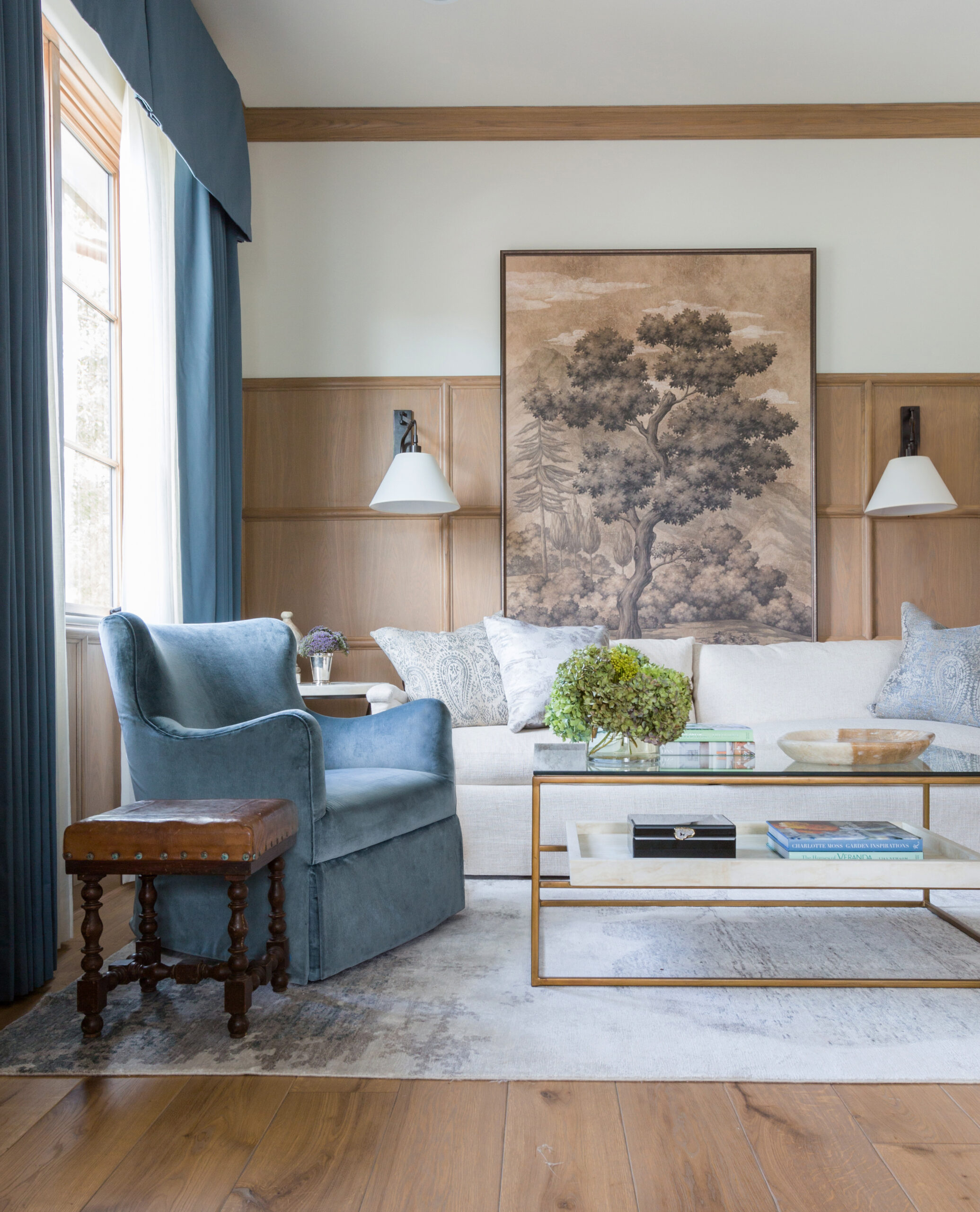Fantasizing about opening your own firm? Wondering what it’s like to run the show? It’s easy to focus on what you can lose instead of thinking about what you can win says Benni Frowein, CEO of Schumacher Europe. To help kick-start your dreams and put you on the path to being your own boss, he sat down with three successful entrepreneurs—Brad Ford of Brad Ford ID, Alexa Hampton of Mark Hampton and Lauren Lowe of Lauren Elaine Interiors—who know what it takes to go from taking orders to calling the shots.

Atlanta-based designer Lauren Lowe launched her residential interiors business after cutting her teeth in corporate office design—and never looked back. Design by Lauren Elaine Interiors featuring Marwari Horse wallpaper in Navy.
Emily FollowillWhy Strike Out on Your Own?
The reasons to go your own way are as varied—and valid—as the fabrics found in a designer showhouse. “I felt like I had a point of view that I wanted to get across and I liked the idea of having more control,” says Brad Ford, who worked with famed interior designers Jed Johnson and Thad Hayes before opening his firm.
Lauren Lowe, meanwhile, got burned out doing corporate office design, and after some soul-searching decided to make a big switch. “I studied interior architecture, and we always teased the residential designers. We said, ‘Oh they just spend all day picking out fringe.’ After seven years of doing corporate design, I realized that the people in charge of the budgets didn’t really care about design,” says Lowe. “I just wanted to sit and think about fringe and not have the man in charge tell me he was cutting my fringe out of the budget!”
And Alexa Hampton? She was born into the design world thanks to her father, Mark Hampton. When he passed away, she was abruptly named his successor. “As I child, I would see my father work and think, ‘Wow, I want to do that,’” says Hampton. “But I certainly didn’t expect to be 27 and suddenly running his business. That wasn’t an expectation, nor was it welcome because the circumstances were tragic.”
What to Know Before Taking the Leap
It’s going to take a lot of hard work, and the payoff might not come in the first year or even two, but the rewards of entrepreneurship are worth it. “You have to be willing to make sacrifices, especially at the beginning. I think that’s one of the things that holds people back from shifting gears and trying their own thing,” says Ford. “They want change, but they don’t want to change their lifestyle.” Another big adjustment, says Ford, is the fact that suddenly you’re the boss. “I couldn’t turn the problem over to someone else. I was the person that they needed to speak to.”
You also need to learn to embrace fear and let it drive you. “When you go into business, it’s scary and that’s okay,” says Hampton. “It’s not uncommon to feel fear. Fear keeps you honest and it keeps you hungry and it also keeps you open to learning from other people.”
The Best Advice for Beginners?
“Keep it lean, keep it scrappy, have as little expenses as possible, and just run a really tight ship,” says Ford. Don’t invest in things like splashy offices and luxury stationery until you’ve got projects in the pipeline and more money coming in than going out.
There are two things you should invest in, though, say our panelists: good photography and a good website. Unless you have a rich aunt, no one is going to hire you without a portfolio. “I did some very small projects in the beginning, and I invested in good photos so I could show people that I had a point of view and I knew what I was doing,” says Lowe. “Those photos were so expensive but so worth it because that was the only way to advertise myself.” As for that website? Ford points out that services like Squarespace have made it very affordable to create the sort of professional-looking site that might have cost $20,000 a few years ago. “It’s not a big expense, but you have to have one,” says Ford.
Another entrepreneurship tip: Ask for help. Ford says it’s surprising how many established designers offered him help and advice when he asked for it, and Hampton agrees. “I’m never shy about picking up the phone and calling somebody like Bunny Williams or David Kleinberg and saying, ‘So what do I do here?’ They always share, which is wonderful.”
Lastly, and perhaps most importantly: Say yes to every project, no matter how small or unappealing. “If someone asks you to arrange pumpkins on their front porch, say yes and document it and put it on social media,” says Lowe. Adds Ford: “You have to set your ego aside and be open to any opportunity that comes your way in the beginning. Someone reached out to me about replacing the carpet in their apartment. Not a great job, but that led to new drapes, which led to new furniture, and it ended up being a real project. Not every job is going to be something amazing that you want to photograph, but that pays the bills.” And, says Lowe, that job could lead to your next big client.
Key Ingredients for Success
Set your design talents aside for a moment, because in many ways, taking care of your finances is the most important part of building a successful business. To that end, you’ve got to start with a business plan, and at least one project in the pipeline so you have some income. “It really all comes down to a numbers game, and what’s coming in and what’s going out,” says Ford. He advises that you make a detailed projection of your expenses, “and then say, okay, I need to have three projects with this budget, and I need to bill this many hours per week to cover those expenses. It’s all about manifestation. If you can come up with a number, you can figure out how to get there.”
“You also have to be the type of person who never gives up, even if you’re not really that type of person,” says Lowe. “Life can kick the drive to succeed out of you, but you’ve just got to keep going through the hard times and the fear and don’t be afraid to take big risks. When you’re dealing with a difficult client or you feel like a project is failing, you’ve got to keep your eye on the big picture and focus on what you’re learning and how this experience is giving you the tools to get to the next level.”
And even though you may be just starting out, you have to take yourself seriously. “In this industry, you have to be an authority,” says Hampton. “Start taking those steps to establish yourself—also to yourself—as an authority in your field. Learn to speak about what you do, how to sit down with a client and talk about your work and show them that you are practical and talented and trustworthy. Knowing how to speak about your work authoritatively is so important.”
Ever practical, Hampton also recommends getting your degree and working for someone amazing for a few years before setting out on your own. “You can get that template and see how they do it. It’s great training.”
Plan for Mistakes and Downturns
“The really scary thing about our line of work,” says Hampton, “is that you have to wait for the next call. You could do the most amazing job ever, but what are you going to do when it’s done and no one calls? You can’t get drunk on success. You’ve just got to hold steady, and when you make some money, sock it away, sock it away, sock it away.” Why? Because you might be doing well now, but you’ll need money to tide you over in lean times like the 2008 downturn or the hard years after 9/11. And when you do have money in your coffers, Ford advises applying for a line of credit to give you some flexibility down the road. “You don’t have to touch it or even have a plan for it, but hold on to it because it’s a lot easier to get when you’ve got money in the bank.
And as for mistakes? They are inevitable—and often costly to fix, but it’s crucial that you address them right away. “You have to learn how to admit to making a mistake. If you try to pretend it’s right, then the trust is gone,” says Lowe. “And that’s where your rainy day money or your profit and loss insurance comes in. It allows you to own the mistake and say ‘It’s my fault, let me fix this for you.’”
Know That Entrepreneurship Gets Easier
“It can be embarrassing to want success for yourself and to say you want to be great,” says Hampton. “But when you get to a point where you’re not totally horrified and embarrassed by that desire for yourself, that’s a big moment.”
In addition to providing an incomparable sense of achievement, starting your own firm makes future endeavors that much easier, says Ford. With the experience of running his own firm under his belt, he felt confident enough to start Field + Supply, a modernist craft fair in upstate New York, which then led to the opening of Fair, his retail store in New York City. “I learned so much about starting a new business, and I was much better prepared the second and third time around. And now it’s fun. All the hard work is so worth it.”
Lowe echoes those thoughts. “I had to keep telling myself two years ago there’s some humps and some hard times and I just have to get through them,” says Lowe. “Then all of a sudden, one day it just stopped being quite as hard and scary, and I haven’t looked back. I would do it all over again in a hearbeat.”
Want to listen to our full conversation about entrepreneurship in interior design? Watch the full video with Brad Ford, Alexa Hampton, Lauren Lowe and Benni Frowein below and be sure to follow Schumacher on YouTube for more interviews with interior design tastemakers and webinars on the business of design.



